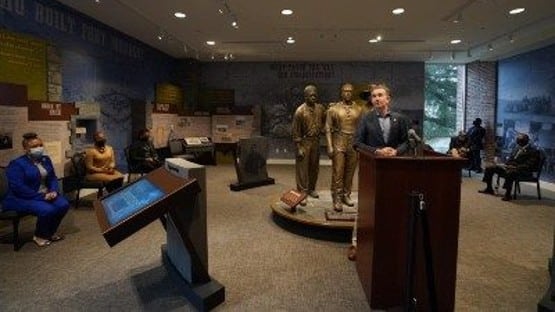
In the early 1600s, an exploration mission headed by Capt. Christopher Newport identified the channel between the Chesapeake Bay and Hampton Roads, Virginia as a strategic defensive location.
Fort Monroe, named in honor of President James Monroe, was completed at the site in 1834, and remained in Union hands during the American Civil War.
For two years after the Civil War, former Confederate States of American President Jefferson Davis was imprisoned at Fort Monroe.
In September 2011, the fort was deactivated as a military fort of the United States, but its place in American history cannot be deactivated.
Fort Monroe was designated a National Historic Landmark in 1960, listed on the National Register of Historic Places in 1966, and designated a National Monument by President Barack Obama in 2011. The United Nations Educations, Scientific and Cultural Organization designated the fort a Site of Memory Association with the Slave Trade Route in 2021.
The site is managed and protected by the Fort Monroe Authority, a political subdivision of the Commonwealth of Virginia.
The Fort Monroe Authority will receive $75,000 in grant funding from the National Park Service for the Fort George Resource Protection Survey at Fort Monroe. The funding is through the Semiquincentennial Grant Program in commemoration of the 250th anniversary of the United States.
“The purpose of this award is to better understand the site of Fort George, the earliest masonry fort built in Virginia, in order to protect this significant historic resource,” Glenn Oder, Executive Director of the Fort Monroe Authority, said. “ForGeorge played a critical role in guarding the entrance to Hampton Roads, the colony’s vital artery of trade and communications.”
Little is known about the Fort George site except what was revealed from recent surveys. Further archival and archaeological exploration of the site promises to shed light on the daily lives of its occupants, including Commodore James Barron, the leader of Virginia’s State Navy during the American Revolution, who was born at Fort George while it was under his father’s command, and who witnessed first-hand as a young boy its destruction from a powerful hurricane in 1749.
Fort George and the majority of the lands at Fort Monroe are in a Special Flood Hazard Area. The threat of sea level rising means research, survey and investigation of the site are imperative before the history is lost.
“Virginia’s rich and diverse history is worth protecting,” Virginia Sens. Mark R. Warner and Tim Kaine said. “We are thrilled to see this substantial funding go towards the restoration and preservation of some of the most notable sites that shaped not just Virginia, but the entire country.”










